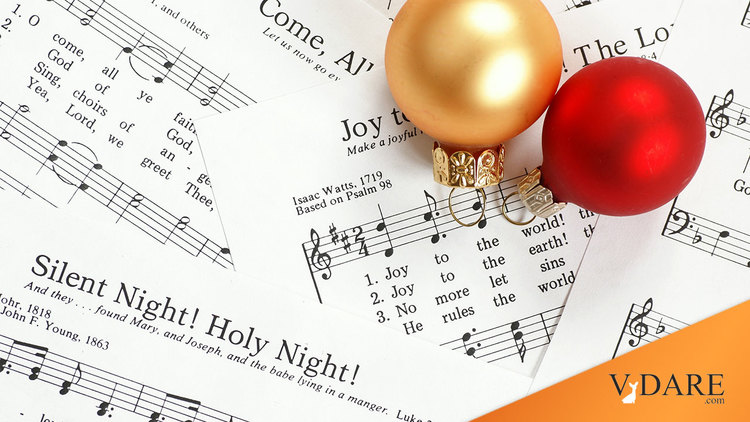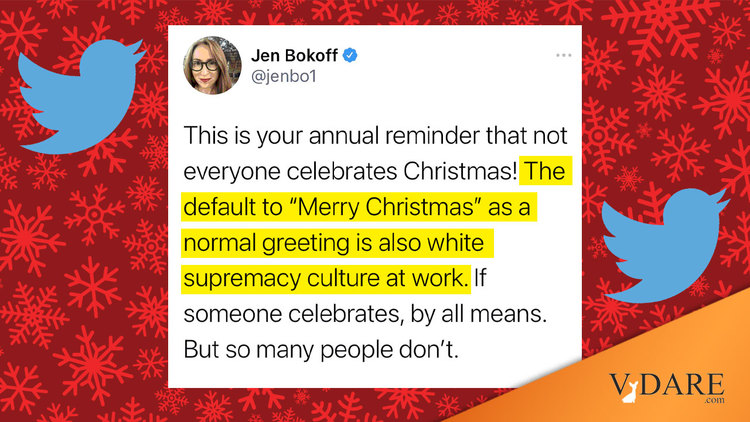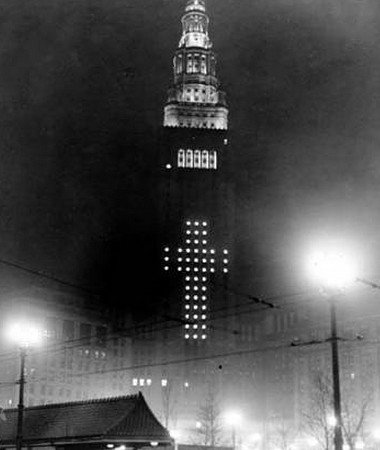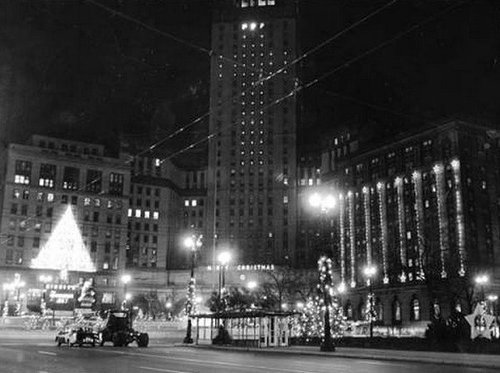
Our Elites Claim Christmas Is "White Supremacy Culture At Work." Their Problem: The Music Is So Beautiful
By Tom Piatak
12/02/2021
UPDATE: A YouTube user has set up what he calls Tom Piatak’s Christmas Playlist, based on the music mentioned in the article below Click here for the full playlist.
By James Fulford writes: Tom Piatak’s great article, below, was published on January 5 of this year, in time to be the main article for January 6, Epiphany. Unfortunately, this was the same date as the Mostly Peaceful Protest at the U.S. Capitol, which led to this article getting a lot less attention than it deserves. Slightly edited and with added links and carols, we present it to you as the opening of our annual War on Christmas Competition.
If you find any instances of especially egregious anti-Christmas hate or suppression, especially local stories that don’t make the national news, mail them to me, or to Peter Brimelow, .
A since-deleted tweet indicated that some of those emboldened by Joe Biden’s “victory” are now eager to redouble the effort to suppress the public celebration of Christmas. "Philanthropy professional" Jen Bokoff, awarded a blue checkmark by Twitter, tweeted shortly before Christmas 2020: “This is your annual reminder that not everyone celebrates Christmas. The default to ‘Merry Christmas’ as a normal greeting is also white supremacy culture at work. If someone celebrates, by all means. But so many don’t.”

Shortly after Christmas the person the Washington Post once promoted as, I kid you not, its conservative representative, Jennifer Rubin, used her Blue Checkmark to write something very similar:
As The Post’s Dan Balz writes, “For Trump supporters, cultural preservation of an America long dominated by a White, Christian majority remains a cornerstone of their beliefs.” That is the definition of white supremacy.
[America isn’t ‘hopelessly divided.’ It only looks that way because of our Constitution, December 28, 2020]
Rubin’s linking of Christmas or voting for Trump or anything else to “White Supremacy” in America 2021 cannot be seen as anything other than an attempt to suppress whatever is being linked.
But her branding Christmas as a manifestation of “white supremacy culture” is a hard sell, since Christmas is celebrated by people of all races in America, not just whites.
Nor is “cultural preservation of an America long dominated by a White, Christian majority” the “definition of White supremacy.” “White supremacy” is in fact defined by things like de jure segregation, eugenic laws, and limiting the franchise to whites, none of which have been present in America for a very long time. What Rubin means by “White Supremacy” is, obviously, whites.
A nation’s desire to preserve its culture is simply normal and natural and part of what countries everywhere seek to do. Presumably there is no real objection, even at the Washington Post, to India seeking to preserve Indian culture, China seeking to preserve Chinese culture, Japan seeking to preserve Japanese culture, and Israel seeking to preserve Jewish culture — just as there is no real objection to public celebrations of Chinese New Year, Diwali, Bodhi Day, Hanukkah, or any other holiday that can be discovered, promoted, or invented to water down the public celebration of Christmas.
As I have argued since 2001, multiculturalism is at the heart of the contemporary assault on Christmas. And as I have also argued since 2001, the best way to defend Christmas is to insist on the excellence of the culture of which it is a part, an excellence that is appreciated by all the Chinese, Japanese, and Koreans who have embraced Western classical music, all the people from all manner of cultures who flock to see the great Western cathedrals and basilicas and were shocked by the fire at Notre Dame (still unexplained), and even all the people who choose to live in countries dominated by “a White, Christian majority” when so many other options are available to them.
Angry tweets from Blue Checks are not the only way to undermine Christmas and the broader culture that created a multifaceted celebration to mark the birth of Christ. We can also do that to ourselves when we fail to pass on what we have received.
And, unfortunately, in too many instances American radio stations playing what they call “holiday music” or even “Christmas music” foster such cultural amnesia.
Many friends and acquaintances have complained to me that, in tuning into Christmas music on the radio, they no longer get even a tiny sampling of traditional Christmas music. Instead, what they hear are playlists largely limited to a handful of songs that are ridiculously overplayed because they are performed by famous rockers or mention rock in the title (John Lennon and Yoko Ono’s “So This Is Christmas,” Bruce Springsteen’s “Santa Claus Is Coming to Town,” “Do They Know It’s Christmas” and its myriad performers, “Rockin’ Around the Christmas Tree,” “Jingle Bell Rock”), absurdly revived obscurities (“It’s a Marshmallow World,” “I Want a Hippopotamus for Christmas”), and a bevy of pop tunes of varying quality that make some reference to winter, snow, Santa, shopping, and, in the best of them, the joy and good feelings that accompany Christmas.
But even the best of these pop songs stringently avoid telling us what Linus so memorably told Charlie Brown — what Christmas is all about.
It’s vital to realize that it didn’t used to be this way. And there is no reason for it to be this way now.
Back in 2003, I reported that Paula Simons got to the heart of the matter when she wrote:
Traditional Christmas carols are beautiful songs. They combine rich, lyric poetry with melodies of timeless power. A child who grows up hearing and singing the likes of God Rest Ye, Merry Gentlemen or Silent Night … or the other great world classics gets a profound musical education. The intricate harmonies and modalities of real carols don’t just move our hearts. They train our ears to appreciate more sophisticated musical forms and our voices to sing in concert with others.
[Cultural Censorship is Ruining Christmas Carols, by Paula Simons, Edmonton Journal, December 17, 2003]
I know that Ms. Simons got it exactly right because what she described is what happened to me.
My musical education began by listening to the many great Christmas records my parents enjoyed playing throughout the Christmas season. Among the first voices I recognized outside of my immediate family were those of Bing Crosby and Frank Sinatra. And I first heard those voices on Christmas albums that were owned by millions of Americans. On these albums Crosby and Sinatra each sang secular Christmas songs such as “White Christmas,” “Silver Bells,” “The Christmas Waltz,” and “Have Yourself a Merry Little Christmas.”
These songs were popular when they were written and remain so, for good reason: they are comparable in quality to the standards Crosby and Sinatra sang outside of December and can serve today as an introduction to what has become known as the Great American Songbook. But no one listening to those albums could fail to understand what Christmas was all about, since each also featured several traditional Christmas carols sung with feeling and artistry. Bing Crosby’s “God Rest Ye Merry Gentlemen” and Frank Sinatra’s “The First Noel” have long been favorites of mine.
Singers of less prominence than Crosby and Sinatra followed the same formula in their own Christmas albums, singing both secular Christmas songs and traditional carols. And they also crossed over into classical music appropriate for Christmas.
Indeed, Andy Williams’ second Christmas album included both of the most popular versions of the “Ave Maria,” the one derived from Franz Schubert’s music for Lady of the Lake and the other fitted to the music of Johann Sebastian Bach by Charles Gounod. I was particularly fond of Robert Goulet’s Christmas album, which ended with four powerful performances of religious music. I am quite certain that the first time I ever heard César Franck’s “Panis Angelicus” was on that album.
And among American popular singers, Goulet’s stirring rendition of the operatic “O Holy Night” is matched only by Nat King Cole’s exquisite version. (It is unclear if Cole’s race would be sufficient to erase the taint of his Christianity in the eyes of Bokoff and Rubin, but Crosby, Sinatra, Williams, and Goulet were all white Christians and therefore part of the culture that Bokoff and Rubin think impermissible to preserve.)
My parents also had Christmas recordings made by popular choral groups. One, by the Harry Simeone Chorale, featured the initial recording of the song made famous by the group, “The Little Drummer Boy.” The Harry Simeone record also brought home to my young ears the sheer variety of Christmas music, featuring carols originating in Spain, France, and Germany in addition to England and America, including the utterly charming tale of how the animals helped the Holy Family, “The Friendly Beasts.”
Even more impressive to me was Robert Shaw’s “The Many Moods of Christmas,” which featured four carol medleys arranged by Robert Russell Bennett. As with the Harry Simeone record, these carols came from all over Christendom, including the French “Pat a Pan” and “The March of the Three Kings” (the music for which was used by Georges Bizet in his L’Arlésienne Suite No. 2), the Spanish “Fum, Fum, Fum,” and “Break Forth O Beauteous Heavenly Light,” a Bach chorale used in his “Christmas Oratorio.” (The record also impressed my junior high choir director, since we sung both “Pat a Pan” and “Break Forth O Beauteous Heavenly Light” in our Christmas concert, back when public schools still had Christmas concerts denominated as such and featuring religious Christmas music.)
I loved it all, but my favorite was and remains the third medley, which begins well enough in England with “What Child Is This” and “Hark! The Herald Angels Sing” and ends even stronger in France, with “Bring a Torch, Jeannette, Isabelle” and “Angels We Have Heard on High” blended together so beautifully that, if I were ever forced to choose just one carol as my favorite, it would likely be the one about two French village girls hurrying to see the baby Jesus and His Mother.
Songs by such choral groups used to fill American airwaves and Americans’ home record collections.
Later in life, I acquired a fondness for another Christmas record of that type that I did not grow up with but a friend did. One evening I came home to find that my very thoughtful friend had, unbeknownst to me, set up and decorated my Christmas tree while I was working. He had also set up a CD to play in a continuous loop on my stereo, Fred Waring and the Pennsylvanians’ “Now Is the Caroling Season.”
It was a very welcome and memorable Christmas present to someone who was feeling particularly harried at work.
Given the way I first heard it, it is unsurprising that I love this Fred Waring recording, but the whole album is excellent, particularly “In Sweetest Jubilee,” an adaptation of “In Dulci Jubilo"; “Masters in This Hall,” a carol I have heard nowhere else; and the concluding “March of the Kings,” an adaptation of the same music used by Bizet. The lesson taught by these popular records was that, although there were many facets to the Christmas celebration, and room for the type of secular Christmas songs made popular by singers such as Crosby, Sinatra, Williams, and Goulet, the focus of the celebration was the birth of Christ.
The television specials featuring such singers drove that lesson home even further. Those shows would often feature a good deal of lighthearted fun, but they all eventually turned into reverent performances of religious Christmas music. That was the highpoint of the show.
Examples include “Silent Night” sung by Dean Martin and Frank Sinatra and their families, “Ave Maria” sung by Perry Como and by Karen Carpenter in 1977, the same year that saw Johnny Cash getting Carl Perkins, Jerry Lee Lewis, Roy Orbison, Roy Clark, and the Statler Brothers to join him in singing “Children, Go Where I Send Thee” after Cash had described his visit to Bethlehem and talked unabashedly about his Christian faith.
Such was American TV before the War on Christmas.
My love for all of these products of American culture undoubtedly helped to inoculate me against the attempts to suppress the public celebration of Christmas that were to grow stronger and more insistent as I got older. But that inoculation was reinforced by a less typical experience in America.
As a child, my Grandma Piatak used to sing Polish Christmas carols for her mother. When I was a child, my Grandma no longer sang those Polish carols, but she did delight in playing a record of a playing a dozen or so of the most popular Polish carols. I liked them, even though I had no idea what they meant, so my Grandma told me about them.
The bottom line is this: even though I still know only what a few of the words mean, I know that none of these carols are about snow, or shopping, or Santa. They are all about Christmas, and often beautiful (such as “Lulajze Jezuniu,” quoted in a scherzo by Chopin and sung in translation by the Three Tenors; or “Zlobie Lezy,” sung in English as “Infant Holy, Infant, Lowly”) or exuberant (such as “Dzisiaj w Betlejem,” used as the music for a charming cartoon of the Nativity that racked up hundreds of thousands of additional hits this Christmas), or both, depending on the emphasis of the performers (such as these contrasting performances of perhaps the most popular Polish carol, “Wsrod nocnej ciszy.”)
Exposure to this tradition also helped prepare me to see through two of the arguments offered ad nauseam by the Christmas deconstructionists.
I remember one law school classmate pompously dismissing Christmas as a thinly disguised continuation of the pagan celebrations of the Winter Solstice. I kept quiet, but thought: how would you explain all the Polish Christmas traditions so obviously rooted in Christianity?
The principal meal is not an elaborate feast, but a simpler dinner on Christmas Eve, meatless because of the fasting requirements formerly imposed by the Catholic Church. That meal does not begin until the first star of the evening is sighted, a reminder of the Star of Bethlehem. The meal starts with the sharing of oplatki, wafers of unleavened bread reminiscent of the host used for Holy Communion and featuring pictures of the Nativity. The table is often covered (generally under the tablecloth) with straw, to remind the diners of the manger where Christ was born.
We’re a long way here from Yule logs or Saturnalia.
The other intellectual benefit I received from my familiarity with this tradition: a skepticism toward the multiculturalist rationale offered to diminish Christmas.
I am fairly certain my pompous classmate had never heard of Polish Christmas carols, much less ever heard one, and knew nothing of all the traditions I recalled as he lectured us, even though those traditions are observed, to some extent, by millions of Americans. If learning about how other people do things were the goal, schools would teach children about the many different Christmas traditions brought to America from all over the world.
But that’s not what schools do, because that’s not what multiculturalism is all about. It’s about indoctrinating children to believe there is something inherently wrong with Western, Christian culture.
Hence, the War on Christmas and also this 2020s wave of iconoclasm, among other things.
Of course, Poland is far from unique in having rich Christmas traditions all its own. One memorable Christmas gift my Dad’s brother brought back to Cleveland in 1974 from the exotic climes of Manhattan was a record called “Christmas at St. John’s” featuring the choir of St. John’s College in Cambridge and the organist Stephen Cleobury. That was my introduction to the unsurpassed excellence of the great English choirs, and also my introduction to some beautiful Christmas music I had never heard before, including the haunting Welsh lullaby, “Suo Gan.” Every carol on that album is a treasure, including the song that my uncle told me was his favorite, “The Holly and the Ivy.”
As for Stephen Cleobury, he became the choir director at King’s College, Cambridge. In that role, he spent decades leading the choir in performing the carols that were part of the Festival of Nine Lessons and Carols broadcast every Christmas Eve around the world by the BBC.
Eight years later saw an introduction to another facet of the beauty that has developed over centuries to accompany Christmas. That was the year PBS broadcast Luciano Pavarotti’s amazing Christmas concert in Montreal from four years before. That concert was held in a perfect venue, Montreal’s stunning Notre Dame basilica, below:

Pavarotti’s voice was at its peak, and he needed no microphone to thrill the spectators jammed into every corner of the church.
The “Adeste Fideles” with which Pavarotti ended the concert remains the most memorable performance I have ever heard of the great carol that begins the Christmas service in thousands of churches around the world every year. (I also remain particularly fond of Pavarotti’s rendition of “Gesu Bambino,” which I heard, for the first time, at my junior high Christmas concert a few years before.)
My third year at Michigan Law school saw another memorable step in my Christmas-inspired musical education. Some background: the school’s new Dean, Lee Bollinger, kept his first Christmas in that role by forbidding the law student singing group from performing Mel Torme’s “Christmas Song” at the end of semester gathering right before our “winter break” [Dean Secularizes Concert, Res Gestae, December 7, 1988].

Bollinger claimed to the singers that he actually liked the piece, and that he might have allowed it if the song mentioned Christmas quickly and inconspicuously. But he felt that men and women who would soon be working in the nation’s top law firms should not be expected to tolerate the robust “Merry Christmas” with which the song ends.
Bollinger, who is now president of Columbia University, certainly knew how strongly the winds of Political Correctness would soon be blowing.
This was the depressing backdrop to attending, for the first time, a performance of Handel’s Messiah at Michigan’s Hill Auditorium with two law school friends.
It was a night I will never forget: there is a reason Handel regarded Messiah as his crowning achievement, and why Haydn exclaimed “Handel is the master of us all” after hearing it performed in London. Given the Grinch-like way Lee Bollinger had just canceled Mel Torme, I’ll admit I felt like one of the Whos standing around the Christmas tree when I followed tradition and stood for the Hallelujah chorus. (Although Messiah premiered in Dublin at Easter, it is also perfectly suited to Christmas, and its first American performance, in Boston, was at Christmas).
Since law school, I have continued to attend Christmas concerts and buy Christmas music. (A particular favorite is Deutsche Grammophon’s “An Old World Christmas,” which focuses on German Christmas music, including a recording of “Es Ist Ein Ros Entsprungen” so beautiful that I used it to illustrate why public school students should be allowed to perform religious Christmas music at a meeting of the local chapter of the Federalist Society.)
Such is the cultural depth and breadth of Christmas that each year I discover something previously unknown to me that so captures the spirt of Christmas that I come back to it again and again and share it widely with friends. This year’s discovery was a carol medley performed at Carnegie Hall not long after I graduated from law school, featuring the black soprano Kathleen Battle and German-American Frederica von Stade,several choirs, and an orchestra conducted by André Previn.
One look at the composition of the performers, beginning with Kathleen Battle, explodes the lie that the celebration of Christmas has anything at all to do with “white supremacy.”
And one listen drives home the point that no matter how assiduously the Main Stream Media promote them as alternatives to Christmas, no other winter holiday can match Christmas. It is possible to imagine an equally magnificent medley featuring dozens of other Christmas carols. It is impossible to imagine even one comparable medley put together by music inspired by any other winter holiday.
When I first started writing about the War on Christmas nineteen years ago, I feared that the suppression of all public observance of Christmas was a real possibility.
But thanks to ordinary Americans’ great attachment to Christmas, that has not happened. We have yet not returned to the days when great cities observed Christmas by lighting up skyscraper windows to form crosses at night, or major newspapers ran unabashedly religious editorials each Christmas, or students in public schools learned about the major holiday of their civilization by singing religious Christmas carols and by putting on religious Christmas plays, or in which major American corporations produced a new Christmas record each year to give to customers and vendors, the way Goodyear and Firestone used to do. But there still are public figures and public spaces celebrating Christmas, and attempts to replace Christmas with “holiday” now often meet determined opposition.

Above, Cleveland’s Terminal Tower, 1938, displaying lights in the shape of a cross for Christmastime, below, the same tower in1957.

Considering what has happened to the conservative side in many other fronts in the Culture War, that is no mean achievement.
The next task should be comparatively easy. I am not suggesting that radio stations stop playing “White Christmas” or “Silver Bells” or even “All I Want for Christmas Is You.” But they should greatly expand their Christmas playlists.
If enough Americans begin asking broadcasters to make a little more room for the real meaning of Christmas and all the beautiful music that it has inspired, you may be pleasantly surprised one future December by turning on the radio and hearing Frank Sinatra singing about Jesus, Karen Carpenter singing about Mary, Fred Waring’s Pennsylvanians singing about the Three Wise Men — and maybe, just maybe, Kathleen Battle singing “O Holy Night.”
Thomas Piatak is a contributing editor to Chronicles: A Magazine of American Culture. He writes from Cleveland, Ohio.
